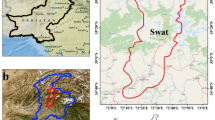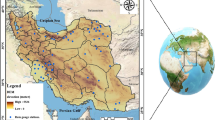Abstract
Quantifying the soil loss in the Western Ghats Region (WGR) is challenging due to limited long-term observation data and accessibility issues, as well as the WGR spanning multiple administrative units. This study aimed to estimate long-term spatiotemporal variations in soil loss rates across the WGR. Using remote sensing inputs, such as LANDSAT-8, Digital Elevation Model (DEM), and rainfall records to estimate soil loss rates using the USLE method from 1990 to 2020. Results indicated that the average soil loss for the WGR was 32.3, 46.2, 50.2, and 62.7 Tons ha−1 yr−1 for 1990, 2000, 2010, and 2020, respectively, showing a concerning 94% increase, and an consistently increasing trend. The state-wise increase is highest in Tamil Nadu (121%), followed by Gujarat (119%), Maharashtra (96%), Kerala (90%), Goa (80%), and Karnataka (56%). These high rates of increase in soil loss are unsustainable to support the biodiversity of WGR and can lead to permanent destruction. The study highlights the importance of considering the long-term effects of land use change on soil erosion and the need for sustainable land management practices, and benefits of using open source satellite products for monitoring. The results can be used to sensitise government agencies on the need to protect the natural land cover, which will reduce soil erosion. The need for conservation and preservation of the WGR is of paramount importance, and steps must be taken to ensure that the natural land cover is protected and soil erosion is reduced.





Similar content being viewed by others
References
Aiello A, Adamo M and Canora F 2015 Remote sensing and GIS to assess soil erosion with RUSLE3D and USPED at river basin scale in southern Italy; Catena 131 174–185.
Arnoldus H M J 1980 An approximation of the rainfall factor in the Universal Soil Loss Equation; pp. 127–132.
Bannari A, Morin D, Bonn F and Huete A R 1995 A review of vegetation indices; Remote Sens. Rev. 13(1–2) 95–120.
Chen D A 1998 Satellite-sensed distribution and spatial patterns of vegetation parameters over a tallgrass prairie; J. Atmos. Sci. 32 225–1238.
Chinnasamy P 2017 Inference of basin flood potential using nonlinear hysteresis effect of basin water storage: Case study of the Koshi basin; Hydrol. Res. 48(6) 1554–1565, https://doi.org/10.2166/nh.2016.268.
Chinnasamy P, Honap V U and Maske A B 2020 Impact of 2018 Kerala floods on soil erosion: Need for post-disaster soil management; J. Indian Soc. Remote Sens. 48(10) 1373–1388.
Chinnasamy P, Shah Z and Shahid S 2023 Impact of lockdown on air quality during COVID-19 pandemic: A case study of India; J. Indian Soc. Remote Sens. 51(1) 103-120, https://doi.org/10.1007/s12524-022-01619-3.
Choudhury M K and Nayak T 2003 Estimation of soil erosion in Sagar Lake Catchment of central India; In: International Conference on Water and Environment, December 15–18, Bhopal, India, pp. 387–392.
Dahanukar N, Raut R and Bhat A 2004 Distribution, endemism and threat status of freshwater fishes in the Western Ghats of India; J. Biogeogr. 31(1) 123–136.
Dumas P and Printemps J 2010 Assessment of soil erosion using USLE model and GIS for integrated watershed and coastal zone management in the South Pacific Islands; In: Proceedings Interpraevent, International Symposium in Pacific Rim, Taipei, Taiwan, pp. 856–866.
FAO 1978 Report on the Agro-Ecological Zones Project; World Soil Resources Report no. 48.
FAO/UNESCO 1971-1981 Soil Map of the World; Legend and 9 volumes.
Haan C T, Barfield B J and Hayes J C 1994 Design hydrology and sedimentology for small catchments; Academic Press.
Hirt C, Filmer M S and Featherstone W E 2010 Comparison and validation of the recent freely available ASTER-GDEM ver1, SRTM ver4.1 and GEODATE DEM-9S ver3 digital elevation models over Australia; Austr. J. Earth Sci. 57 337–347.
Hlaing K T, Haruyamai S and Aye M 2008 Using GIS-based distributed soil loss modeling and morphometric analysis to prioritise watershed for soil conservation in Bago river basin of Lower Myanmar; Front. Earth Sci. China 2(4) 465–478.
India Meteorological Department 2018 Hydrometeorological Services in IMD; Government of India.
Julien P Y 2010 Erosion and sedimentation; Cambridge University Press, 392p.
Lastoria B, Miserocchi F, Lanciani A and Monacelli G 2008 An estimated erosion map for the Aterno-Pescara river Basin; Eur. Water. 21(22) 29–39.
Lekha K R 2004 Field instrumentation and monitoring of soil erosion in coir geotextile stabilised slopes – A case study; Geotext. Geomembr. 22(5) 399–413.
Liu B Y, Nearing M A, Shi P J and Jia Z W 2000 Slope length effects on soil loss for steep slopes; Soil Sci. Soc. Am. J. 64 1759–1763.
Morgan R P C and Nearing M 2011 Handbook of erosion modelling; John Wiley & Sons.
Nachtergaele F, van Velthuizen H, Verelst L, Batjes N H, Dijkshoorn K, van Engelen V W P and Montanarela L 2010 The harmonised world soil database; In: Proceedings of the 19th World Congress of Soil Science, pp. 34–37.
Nalgire S and Chinnasamy P 2022 Index-based impact monitoring of water infrastructures in climate change mitigation projects: A case study of MGNREGA-IWMP projects in Maharashtra, Front. Water 4, https://doi.org/10.3389/frwa.2022.956161.
NASA 2019 Landsat-8; https://landsat.gsfc.nasa.gov/landsat-data-continuity-mission/.
Pai M 2005 The western ghats, ND Naik, https://scholar.google.com/scholar?hl=en&as_sdt=0%2C5&q=Pai%2C+M.+%282005%29.+The+western+ghats.+ND+Naik.&btnG=.
Parysow P, Wang G X, Gertner G and Anderson A B 2003 Spatial uncertainty analysis for mapping soil erodibility based on joint sequential simulation; Catena 53 65–78.
Phinzi K and Ngetar N S 2018 The assessment of water-borne erosion at catchment level using GIS-based RUSLE and remote sensing: A review; Int. Soil Water Conserv. Res. 7(1) 27–46.
Pradeep G S, Krishnan M N and Vijith H 2015 Identification of critical soil erosion prone areas and annual average soil loss in an upland agricultural watershed of Western Ghats, using analytical hierarchy process (AHP) and RUSLE techniques; Arab. J. Geosci. 8(6) 3697–3711.
Rahaman S A, Aruchamy S, Jegankumar R and Ajeez S A 2015 Estimation of annual average soil loss, based on RUSLE model in Kallar watershed. Bhavani Basin, Tamil Nadu, India; Remote Sens. Spat. Infor. Sci. II(2) 207–214.
Ramachandra T V and Suja A 2006 Sahyadri: Western Ghats biodiversity information system; Biodivers. Indian Scenario 1 1–22.
Renard K G and Foster G R 1983 Soil conservation: Principles of erosion by water; In: Dry land agriculture; Agronomy Monograph, pp. 155–176.
Renard K G, Foster F G, Weesies G A, McCool D K and Yoder D C 1997 Predicting soil loss erosion by water: A guide to conservation planning with the revised universal soil loss equation (RUSLE); US Department of Agriculture.
Rouse J W, Haas R H, Schell J A and Deering D W 1973 Monitoring vegetation systems in the great plains with ERTS; Third 80 ERTS Symposium 351 309–317.
Roy P 2009 Detection of land use/land cover change and its impact on soil erosion. using satellite remote sensing and GIS; In: Proceedings of International Conference on Energy and Environment, pp. 817–821.
Sharon D 1980 The distribution of hydrologically effective rainfall incident on sloping ground; J. Hydrol. 46 165–188.
Singh N and Chinnasamy P 2021 Non-stationary flood frequency analysis and attribution of streamflow series: A case study of Periyar River India; Hydrol. Sci. J. 66(13) 1866–1881, https://doi.org/10.1080/02626667.2021.1968406.
Szabo Szilard 2016 Specific Features of NDVI, NDWI, and MNDWI as reflected in land cover categories; Landscape Environ. 10(3–4) 194–202.
Thomas J, Joseph S and Thrivikramji K P 2018 Assessment of soil erosion in a tropical mountain river basin of the southern Western Ghats, India using RUSLE and GIS; Geosci. Front. 9(3) 893–906.
Thuy H T and Lee G 2017 Soil loss vulnerability assessment in the Mekong River basin; J. Korean Geo-Environ. Soc. 18(1) 37–47.
Tucker C J 1979 Red and photographic infrared linear combinations for monitoring vegetation; Remote Sens. Environ. 8 127–150.
UNESCO 2012 Western Ghats/World heritage list; UNESCO.
Valor E and Caselles V 1996 Mapping land surface emissivity from NDVI: Application to European, African, and South American areas; Remote Sens. Environ. 57(3) 167–184.
Vicente M L, Navas A and Machin J 2007 Identifying erosive periods by using RUSLE factors in mountain fields of the Central Spanish Pyrenees; Hydrol. Earth Syst. Sci. 12(2) 523–535.
Wiegand C L 1973 Vegetation density as deduced from ERTS-1 MSS response; NASA 1 93–116.
Williams J R 1978 A sediment graph model based on instantaneous unit sediment graph; Water Resour. Res. 14(4) 659–664.
Wischmeier W H 1965 Predicting rainfall erosion losses: A guide to conservation planning; Washington DC, US Department of Agriculture, 537p.
Wischmeier W H and Smith D D 1978 Predicting rainfall erosion losses-a guide to conservation planning; Predicting rainfall erosion losses – a guide to conservation planning.
Zhang W, Zhang Z, Liu F, Qiao Z and Hu S 2011 Estimation of the USLE cover and management factor C using satellite remote sensing: A review; In: 2011 19th International Conference on Geoinformatics, pp. 1–5.
Acknowledgements
The authors acknowledge the funding from the Ministry of Human Resources Development (MHRD) and also thank Prof. Kannan Moudgalaya and his project team of the Free and Open-Source Software for Education (FOSSEE), at the Indian Institute of Technology – Bombay (IITB), for funding the internship for this research work, and the Centre for Technology Alternatives for Rural Areas of IITB for providing lab space. The authors thank the NASA team for the open-source remote sensing data that are used in this study.
Author information
Authors and Affiliations
Contributions
Pennan Chinnasamy played a pivotal role in conceiving and directing the project, and made significant contributions to the methodology and interpretation of the results, along with writing, editing and approving the final version. Vaishnavi U Honap was responsible for conducting the data collection, performing geospatial analysis, and preparing a draft of the manuscript.
Corresponding author
Additional information
Communicated by Somnath Dasgupta
Rights and permissions
About this article
Cite this article
Chinnasamy, P., Honap, V.U. Spatiotemporal variations in soil loss across the biodiversity hotspots of Western Ghats Region, India. J Earth Syst Sci 132, 90 (2023). https://doi.org/10.1007/s12040-023-02098-x
Received:
Revised:
Accepted:
Published:
DOI: https://doi.org/10.1007/s12040-023-02098-x




